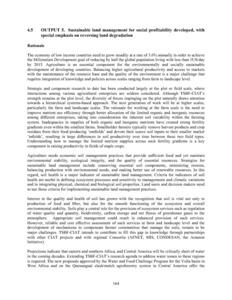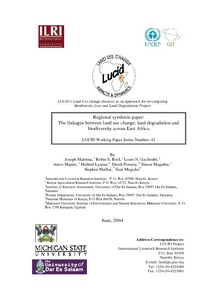The linkages between land use change, land degradation and biodiversity across East Africa
Development pathways and land management in Uganda
This paper investigates the patterns and determinants of change in income strategies ("development pathways"), land management, resource and human welfare conditions in Uganda since 1990, based upon a community-level survey conducted in 107 villages. Six dominant development pathways were found, all but one of which involved increasing specialization in already dominant activities. Of these, expansion of banana and coffee production was most associated with adoption of resource-conserving practices and improvements in resource conditions and welfare.
Strategies for sustainable land management and poverty reduction in Uganda
The government of Uganda, with help from its development partners, is designing and implementing policies and strategies to address poverty, land degradation, and declining agricultural productivity. Land degradation, especially soil erosion and depletion of soil nutrients, is widespread in Uganda and contributes to declining productivity, which in turn increases poverty.
Societal responses for addressing nitrogen fertilizer needs: Balancing food production and environmental concerns
Groene ruimte in de Randstad: een evaluatie van het rijksbeleid voor bufferzones en de Randstadgroenstructuur; achtergronddocument bij Natuurbalans 2004
ertoe geleid dat in de directe omgeving van steden grote open gebieden onbebouwd zijn gebleven. Bovendien zijn er grote groene recreatiegebieden aangelegd die zeer in trek zijn bij omwonenden. Planologische onduidelijkheid, onvoldoende bestuurlijke regie en, daarmee samenhangend, ontwikkelingen op de grondmarkt hebben ertoe geleid dat de aanleg van groengebieden de afgelopen jaren stagneert. Recentelijk is het rijksbeleid overgedragen aan provincies. Deze hebben echter nog moeite om de integrale ontwikkeling van grote groengebieden in samenhang met rood te regisseren.
Improving environmental impact assessment for better integrated coastal zone management
Slash and burn agriculture in the humid forest zone of Southern Cameroon: soil quality dynamics, improved fallow management and farmers' perceptions
La science forestière en soutien des négociations internationales sur les changements climatiques et ses implications locales
Forest science in support to international negotiation on climate change and its local consequences. This article gives an analysis of the major scientific questions underlying the decision making process dealing with forest monitoring under the topic land use, land use change and forestry as a driving force for climate change. It first gives the major scientific findings used as guidelines for political decisions since 1988.
Effects of Poverty on Deforestation: Distinguishing Behavior from Location
We summarize existing theoretical claims linking poverty to rates of deforestation and then examine this linkage empirically for Costa Rica during the 20th century using an econometric approach that addresses the irreversibilities in deforestation. Our data facilitate an empirical analysis of the implications for deforestation of where the poor live. Without controlling for this, impacts of poverty per se are confounded by richer areas being different from the areas inhabited by the poor, who we expect to find on more marginal lands, for instance less profitable lands.
Will Buying Tropical Forest Carbon Benefit The Poor? Evidence from Costa Rica
We review claims about the potential for carbon markets that link both payments for carbon services and poverty levels to ongoing rates of tropical deforestation. We then examine these effects empirically for Costa Rica during the 20th century using an econometric approach that addresses the irreversibilities in deforestation. We find significant effects of the relative returns to forest on deforestation rates. Thus, carbon payments would induce conservation and also carbon sequestration, and if land users were poor could conserve forest while addressing rural poverty.
Impact of geothermal power development on land use and environment in Olkaria, Naivasha, Kenya
Geothermal Energy is a natural form of energy stored deep in the earth's hot rocks and
waters within the fractured rocks. It is fairly widespread in the world mostly within
continental plate margins. It has been put into use for several centuries but commercially;
the world's first geothermal power plant was built at Larderello Italy in 1901 and is still
generating. In Africa, Kenya is the first country to utilize this technology for power
generation in the Rift Valley at Olkaria Naivasha. The geothermal energy potential in








